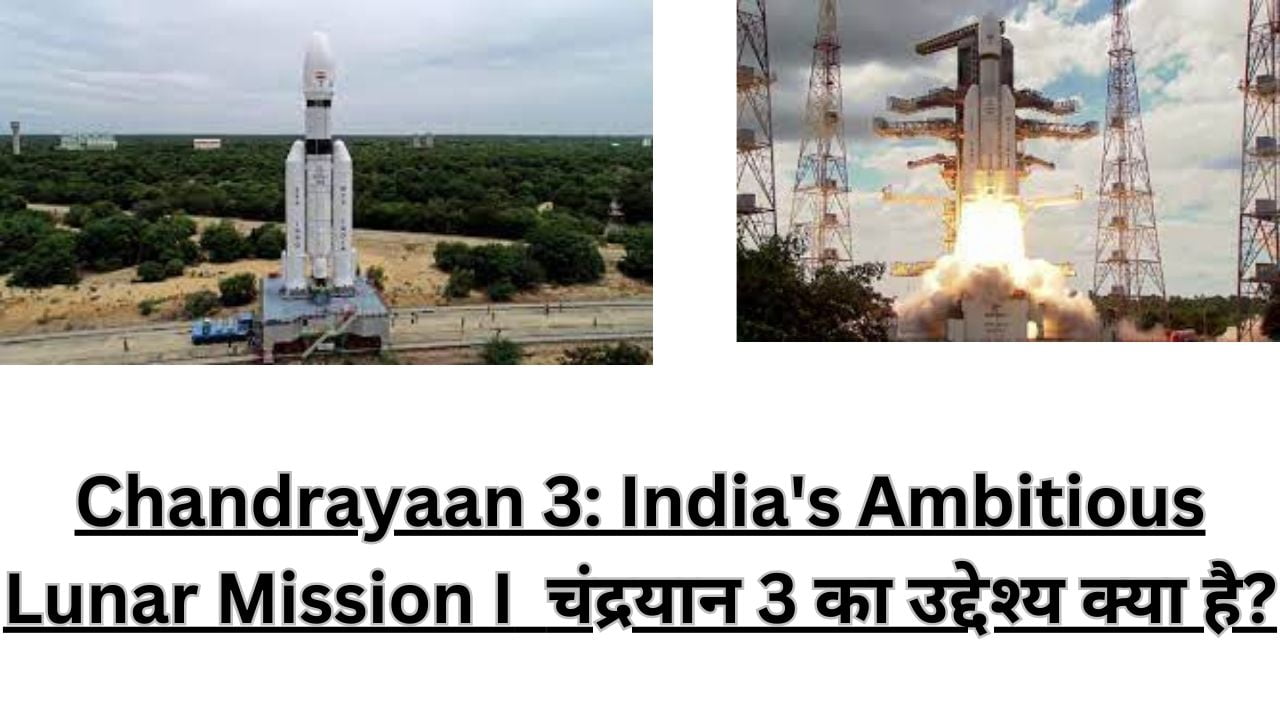
Introduction: Chandrayaan 3 Mission
On the 14th of July 2023, at 2:35 PM, the Indian Space Research Organization (ISRO) will launch the Chandrayaan 3 mission from the Satish Dhawan Space Center. This mission holds immense significance as its primary objective is to achieve a soft landing on the lunar surface, a feat that was not accomplished during the previous Chandrayaan 2 mission. If successful, Chandrayaan 3 will make India the first country to provide concrete evidence of the Earth’s birth through practical proof.
The Significance of Chandrayaan 3
Chandrayaan 3 presents a remarkable opportunity for India to make significant contributions to the field of space exploration. By exploring the moon’s south pole, the mission aims to gather crucial data about the lunar surface, water molecules, magnetic field anomalies, and other aspects that could shed light on the history and evolution of Earth. The successful execution of Chandrayaan 3 will position India as a leading country in space research and boost its confidence for future endeavors.
Challenges of Lunar Soft Landing
Soft landing on the moon poses numerous challenges compared to landing on Mars or other celestial bodies. The moon’s proximity to Earth, shorter travel time, and lack of a significant atmosphere make it more difficult to control the spacecraft and manually correct its position. The time frame for landing is limited to a small window of 15 to 30 minutes, adding to the complexity of the mission. The absence of an atmosphere on the moon also presents challenges in reducing the lander’s speed and protecting the sensors from damage.
ISRO’s Unique Strategy for Soft Landing
To address the challenges associated with soft landing, ISRO has devised a unique strategy for Chandrayaan 3. Instead of landing directly on the lunar surface in the traditional manner, the mission will reduce its speed visually before landing and perform a close orbit around the moon to reevaluate the landing site. These strategic maneuvers aim to ensure a successful soft landing while minimizing the risks that were encountered during previous attempts.
The Architecture of Chandrayaan 3
The architecture of Chandrayaan 3 closely resembles its predecessor, Chandrayaan 2. It consists of a propulsion model and a lander model, with a combined weight of approximately 3900 kg. Modifications have been made to enhance the mission’s efficiency and ensure optimal performance during landing and exploration. The mission will leverage the existing Chandrayaan 2 orbiter for lunar scanning, reducing the need for additional equipment.
Objectives and Instruments on Chandrayaan 3
Chandrayaan 3 carries a specific set of objectives and instruments to accomplish its mission. The primary objective is to conduct a detailed analysis of the lunar south pole and investigate the presence of water molecules and other chemical components in the soil. The lander and rover will utilize instruments such as the laser-induced breakdown spectroscopy (LIBS) and the alpha particle X-ray spectrometer (APXS) to study the composition of the lunar surface. Additionally, instruments like Rambha and CHEMIN sensors will measure heat conduction properties, temperature, and seismic activity.
Home Page Click Here
Read more Understanding Virtual RAM: The Concept and Marketing Tactics Is It Really Important?
The Potential Discoveries of Chandrayaan 3
If successful, Chandrayaan 3 has the potential to unlock valuable insights into the moon’s composition, its relationship with Earth, and the evolution of our planet. The presence of water molecules and magnetic field anomalies on the moon’s south pole could provide crucial evidence supporting the theory of lunar formation from Earth’s fragments. Furthermore, the mission will contribute to a better understanding of the moon’s ionosphere, temperature variations, and the existence of a light layer of atmosphere.
Implications for Understanding Earth’s Evolution
Studying the data obtained from Chandrayaan 3 will enable scientists to gain a deeper understanding of Earth’s evolution and its early history. The mission’s findings regarding the composition of the lunar surface and its correlation with Earth’s composition could provide practical proof of the theories related to the birth and development of our planet. India’s contribution in unraveling these mysteries will enhance our knowledge of planetary science and further consolidate its position in the global space community.
India’s Progress in Space Exploration
Chandrayaan 3 represents India’s continued progress in space exploration. While countries like the United States, Russia, and China have achieved soft landings on the moon, India’s ambitious mission aims to make significant contributions despite budgetary constraints. The successful execution of Chandrayaan 3 will not only boost India’s confidence but also lay the foundation for future missions, including the ambitious Gaganyaan mission to send Indian astronauts into space.
Conclusion
Chandrayaan 3 is a groundbreaking mission that holds tremendous potential for India’s space exploration endeavors. The mission’s objective to achieve a soft landing on the moon’s south pole and gather valuable data about the lunar surface, water molecules, and magnetic field anomalies presents both challenges and opportunities. If successful, Chandrayaan 3 will position India at the forefront of space research and provide practical evidence of Earth’s evolution. This mission marks a significant milestone in India’s journey towards unraveling the mysteries of the universe.
FAQ
Q1: What is the primary objective of the Chandrayaan 3 mission? A1: The primary objective of the Chandrayaan 3 mission is to achieve a soft landing on the lunar surface and gather crucial data about the lunar south pole, including the presence of water molecules and other chemical components in the soil.
Q2: Why is the Chandrayaan 3 mission significant for India? A2: The Chandrayaan 3 mission presents a remarkable opportunity for India to make significant contributions to space exploration. It will position India as a leading country in space research and boost its confidence for future endeavors.
Q3: What are the challenges of soft landing on the moon? A3: Soft landing on the moon is challenging due to factors such as the moon’s proximity to Earth, shorter travel time, lack of a significant atmosphere, and the limited time frame for landing. These factors make it difficult to control the spacecraft and protect the sensors during landing.
Q4: How is ISRO addressing the challenges of soft landing for Chandrayaan 3? A4: ISRO has devised a unique strategy for Chandrayaan 3. Instead of landing directly on the lunar surface, the mission will reduce its speed visually before landing and perform a close orbit around the moon to reevaluate the landing site. This strategy aims to ensure a successful soft landing while minimizing risks.
Q5: What instruments are carried by Chandrayaan 3? A5: Chandrayaan 3 carries instruments such as the laser-induced breakdown spectroscopy (LIBS), alpha particle X-ray spectrometer (APXS), Rambha, and CHEMIN sensors. These instruments are used to study the composition of the lunar surface, measure heat conduction properties, temperature, and seismic activity.
Q6: What potential discoveries can Chandrayaan 3 make? A6: If successful, Chandrayaan 3 has the potential to provide valuable insights into the moon’s composition, its relationship with Earth, and the evolution of our planet. It may uncover evidence supporting the theory of lunar formation from Earth’s fragments and contribute to a better understanding of the moon’s ionosphere and temperature variations.
Q7: How will Chandrayaan 3 contribute to understanding Earth’s evolution? A7: Studying the data obtained from Chandrayaan 3 will enable scientists to gain a deeper understanding of Earth’s evolution and its early history. The mission’s findings regarding the lunar surface’s composition and its correlation with Earth’s composition could provide practical proof of the theories related to the birth and development of our planet.
Q8: What progress does India’s space exploration program demonstrate with Chandrayaan 3? A8: Chandrayaan 3 represents India’s continued progress in space exploration. Despite budgetary constraints, India aims to make significant contributions to space research. The successful execution of Chandrayaan 3 will boost India’s confidence and lay the foundation for future missions, including the Gaganyaan mission to send Indian astronauts into space.
Q9: How does Chandrayaan 3 contribute to India’s position in the global space community? A9: Chandrayaan 3 positions India as a leading country in space research and strengthens its position in the global space community. India’s contributions to unraveling the mysteries of the moon’s south pole and Earth’s evolution enhance its reputation in planetary science and space exploration.
Q10: What is the significance of Chandrayaan 3’s soft landing on the moon’s south pole? A10: The soft landing of Chandrayaan 3 on the moon’s south pole holds immense significance as it aims to provide concrete evidence of the Earth’s birth through practical proof. If successful, India will become the first country to achieve this milestone, marking a significant milestone in the country’s space exploration journey.

One thought on “Chandrayaan 3: India’s Ambitious Lunar Mission I चंद्रयान 3 का उद्देश्य क्या है?”